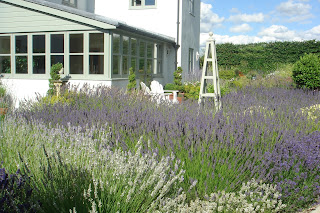
We look out over a sea of Lavender. Above it flutter moving clouds of butterflies while in and about it, busying themselves, is a humming, hurried workforce of bees of all sorts and kinds. Our main Lavender bed washes right up against the house like a sea against a coastline. This was entirely deliberate for we wanted to look out over a Lavender field from the very heart of the home and enjoy the vivid feast of colour and delicious scent.
To extend the season as long as possible, we grow both angustifolia and x intermedia varieties. So we have Lavender in flower from the end of June to mid September. The angustifolias tend to flower earlier and are going over around mid August which is when I cut them back. The x intermedias flower later and are going over by mid-September when they too are cut back hard. This allows the plants to put on around 3cm of growth before Winter which I suspect insulates them during the colder months. But key to the survival and wellbeing of Lavender is the conditions which must be sharp draining, sunny and very dry.
Our list of Lavender plants is now a very long one. The list includes the predictable angustifolia Hidcot but includes more unusual varieties such as Beechwood Blue which I prefer. We also grow Folgate, Felice, Bowles Early, Imperial Gem, Elizabeth, the pink Miss Katherine, the small white Nana Alba and many, many more. The x intermedia range includes Grosso, Sussex and the white Edelweiss.
As well as growing Lavender in beds and along pathways we have many in pots dotted around the garden. If you have problems growing Lavender due to the wrong aspect, soil or outlook then you can always plant up a pot and place it in a sunny spot on a terrace or patio. It should do just fine but do remember to water it. Lavender, even in pots, does need some water to survive.
In Winter I like looking out over a Lavender bed which is dotted by the cobbled effect of the Lavender plants which look like box balls once they have been cut back. On a frosty morning the effect is lovely. In late Spring and before the Lavender flowers, the bed looks like an array of grasses so fresh and green are the shoots.
The fact that Lavender attracts so many insects into the garden only adds to the benefit of growing it and helping to maintain the delicate balance of a healthy garden. Such is the beauty and benefit of Lavender.
